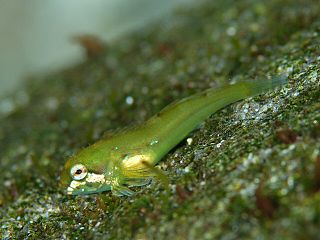
Antipodocottus is a genus of marine ray-finned fishes belonging to the family Cottidae, the typical sculpins. These fishes are found in the western Pacific Ocean. This is the only genus of Cottids represented in the Southern Hemisphere, although their classification in the Cottidae is not universally accepted.

Archistes is a genus of marine ray-finned fishes belonging to the family Cottidae, the typical sculpins. the two species in this genus are found in the northern Pacific Ocean.
The Blackfin hookear sculpin is a species of marine ray-finned fish belonging to the family Cottidae, the typical sculpins. It is the only species in the monospecific genus Artediellichthys. This species is found in the northern Pacific Ocean. It occurs at depths of from 200 to 815 metres. This species grows to a total length of 13.7 cm (5.4 in).

Artediellus is a genus of marine ray-finned fishes belonging to the family Cottidae, the typical sculpins. Most of the fishes in this genus are found in the northern Pacific Ocean but they also occur in the Arctic and North Atlantic Oceans.

The rosylip sculpin is a species of marine ray-finned fish belonging to the family Cottidae, the typical sculpins. This species is found in the eastern Pacific Ocean from Alaska to central California where it is an inhabitant of tidepools and other intertidal environments. This species grows to a length of 15 centimetres (5.9 in) TL. This species is the only known member of its monospecific genus Ascelichthys.
Astrocottus is a genus of marine ray-finned fishes belonging to the family Cottidae, the typical sculpins. These fishes are found in the northwestern Pacific Ocean.

Bero elegans is a species of marine ray-finned fish belonging to the family Cottidae, the typical sculpins. This species is found in the northwestern Pacific Ocean. This species grows to a length of 20 centimetres (7.9 in) TL. It is the only known member of the genus Bero.
Bolinia is a monospecific genus of marine ray-finned fish belonging to the family Cottidae, the typical sculpins. This taxon is endemic to the northern Pacific Ocean around the Aleutian Islands of Amukta, Carlisle, and Semisopochnoi. It is found at depths of between 201 to 410 metres. This species grows to a length of 18.9 centimetres (7.4 in) SL. The only species in the genus is Bolinia euryptera.

Enophrys is a genus of marine ray-finned fishes belonging to the family Cottidae, the typical sculpins. These fishes are found in the northern and eastern Pacific Ocean.
The lavender sculpin is a species of marine ray-finned fish belonging to the family Cottidae, the typical sculpins. It is found in the eastern Pacific Ocean.

Ocynectes is a genus of marine ray-finned fishes belonging to the family Cottidae, the typical sculpins. This species is found in tidepools in the northwestern Pacific Ocean.
The spineless sculpin is a species of marine ray-finned fish belonging to the family Cottidae, the typical sculpins. This species is found in the Pacific Ocean where it is endemic to the waters around the Aleutian Islands, Alaska.

Porocottus is a genus of marine ray-finned fishes belonging to the family Cottidae, the typical sculpins. These fishes are found in the northern and northwestern Pacific Ocean.

Pseudoblennius is a genus of marine ray-finned fishes belonging to the family Cottidae, the typical sculpins. These fishes are found in the northwestern Pacific Ocean.

Radulinus is a genus of marine ray-finned fishes belonging to the family Cottidae, the typical sculpins. These fishes are found in the eastern Pacific Ocean.

Sigmistes is a genus of marine ray-finned fishes belonging to the family Cottidae, the typical sculpins. These fishes are found in the northern Pacific Ocean.

The sponge sculpin is a species of marine ray-finned fish belonging to the family Cottidae, the typical sculpins. It is the only species in the monospecific genus Thyriscus. This fish is found in the northern Pacific Ocean where it is found at depths from 100 to 800 m though usually in the range of 300 to 400 m. This species grows to a maximum published total length of 14.5 cm (5.7 in).
Vellitor is a genus of marine ray-finned fishes belonging to the family Cottidae, the typical sculpins. These fishes are found in seawedd beds in the northwestern Pacific Ocean.

Zesticelus is a genus of marine ray-finned fishes belonging to the family Cottidae, the typical sculpins. These fishes are found in the North Pacific Ocean.
The spinynose sculpin is a species of marine ray-finned fish belonging to the family Cottidae, the typical sculpins. It is found in the northeastern Pacific Ocean from Alaska south to Washington and the San Juan Islands. The spinynose sculpin is the only species in the monospecific genus Asemichthys. This sculpin lays its eggs on the egg masses of the buffalo sculpin, thought to be a strategy to take advantage of the larger fish’s egg guarding behaviour.













